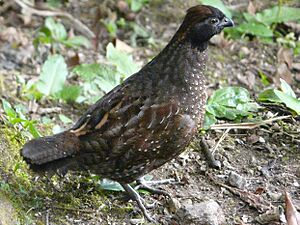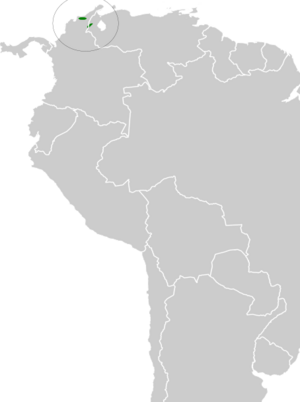Black-fronted wood quail facts for kids
Quick facts for kids Black-fronted wood quail |
|
|---|---|
 |
|
| Conservation status | |
| Scientific classification | |
| Genus: |
Odontophorus (bird)
|
| Species: |
atrifrons
|
 |
|
The black-fronted wood quail (Odontophorus atrifrons) is a cool bird that lives in the forests of Colombia and Venezuela. It belongs to a group of birds called New World quails. These birds are known for their unique calls and how they live together in groups.
Contents
What is a Black-fronted Wood Quail?
The black-fronted wood quail is a medium-sized bird, about 24 to 30 centimeters (9.4 to 11.8 inches) long. Males weigh around 311 grams (11 ounces), and females are a bit lighter at 298 grams (10.5 ounces). Both male and female quails have a special black area on their forehead, face, and throat. This black "mask" helps them stand out!
Different Kinds of Black-fronted Wood Quails
There are three slightly different types, or subspecies, of the black-fronted wood quail:
- O. a. atrifrons (the most common type)
- O. a. variegatus
- O. a. navai
Each subspecies has small differences in its colors and patterns. For example, O. a. variegatus has more black on its head and a browner back. O. a. navai is mostly dark brown without reddish colors.
Where Do They Live?
Black-fronted wood quails live in the mountains of South America.
- The O. a. atrifrons subspecies is found in the Sierra Nevada de Santa Marta in northeastern Colombia.
- O. a. variegatus lives in the northern part of Colombia's eastern Andes mountains.
- O. a. navai can be found in the Serranía del Perijá, which is a mountain range on the border between Colombia and Venezuela.
These quails prefer to live on the ground in tropical and subtropical mountain forests. They usually live at high elevations, from about 1,200 to 3,100 meters (3,900 to 10,200 feet) above sea level. Sometimes, in the Sierra Nevada de Santa Marta, they can be found as low as 700 meters (2,300 feet).
How Do They Live?
What Do They Eat?
Black-fronted wood quails are busy eaters! They often search for food in small groups, called coveys, with up to 10 birds. They scratch through fallen leaves on the forest floor to find tasty insects and berries.
How Do They Raise Their Young?
The breeding season for these quails seems to be from May to August. Only one nest has ever been found and studied. It was a simple bed of dried leaves and small sticks in a hollow on the ground. This nest held three eggs, ready to hatch into new little quails!
What Sounds Do They Make?
These birds have several interesting calls. Their main call, used to attract mates, is a "rhythmic, whistled series" that sounds like "bob-a-white." They also make rattling sounds and "gabbling calls" to talk to other quails in their group.
Are They in Danger?
The black-fronted wood quail is currently listed as Vulnerable by the IUCN. This means their population is decreasing, and they could become endangered if things don't change. The main reason they are at risk is because their forest homes are being destroyed. Their living area is small and broken up, and there are fewer and fewer places for them to live safely.


